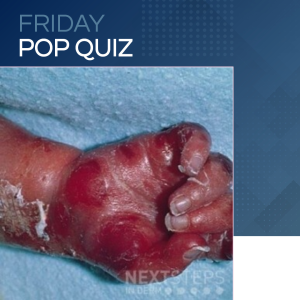
The correct answer is A. Syphilis.
This is pemphigus syphiliticus, the only blistering manifestation of syphilis. It occurs in newborns, who have severe bullous lesions.
Leishmania: Leishmaniasis is a parasitic disease transmitted by sandflies infected with the protozoa Leishmania. Leishmaniasis is endemic in more than 70 countries worldwide and affects an estimated 12 million people. There are several clinical forms of leishmaniasis. The clinical manifestation of the infection depends on the species of Leishmania, which varies with geographic area and the host’s immune response. It does not appear with bullous lesions.
Chlamydia: A genitourinary chlamydial infection may cause very mild symptoms or no symptoms at all. It is asymptomatic in approximately 70% of infected women and 50% of infected men. In men, the most common signs and symptoms of genitourinary chlamydia infection are discharge from the urethra and urethral irritation.
Gonorrhea: Gonorrhea is a disease due to infection with the bacteria Neisseria gonorrhoeae. The common sites of infection are the mucous membranes of the urethra, endocervix, rectum, pharynx, and conjunctiva. Gonorrhea is a sexually transmitted infection.
Tuberculosis: Cutaneous tuberculosis (TB) is essentially an invasion of the skin by Mycobacterium tuberculosis, the same bacteria that cause TB of the lungs (pulmonary TB). Cutaneous TB is a relatively uncommon form of extrapulmonary TB (TB infection of other organs and tissues). Even in countries such as India and China where TB still commonly occurs, cutaneous outbreaks are rare.
References:
Cooper JM, Sánchez PJ. Congenital syphilis. Semin Perinatol. 2018;42(3):176-184. doi:10.1053/j.semperi.2018.02.005. Siegel M, Lee LW. Neonatal Skin Emergencies. Pediatr Ann. 2019;48(1):e36-e42. doi:10.3928/19382359-20181210-03. Rayala BZ, Morrell DS. Common Skin Conditions in Children: Neonatal Skin Lesions. FP Essent. 2017;453:11-17.
